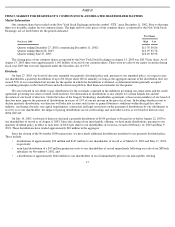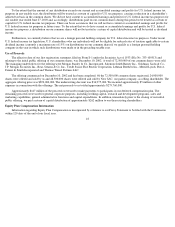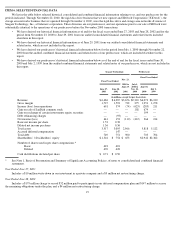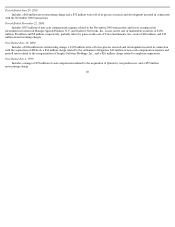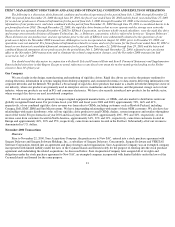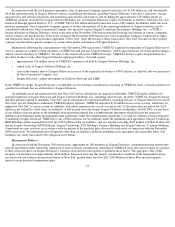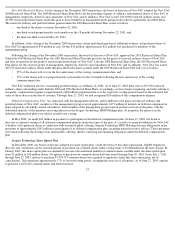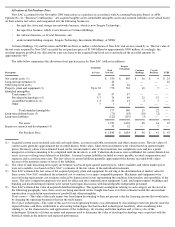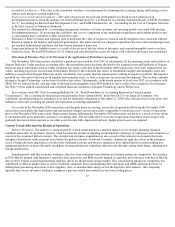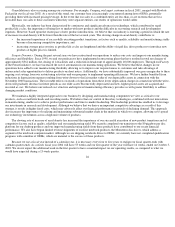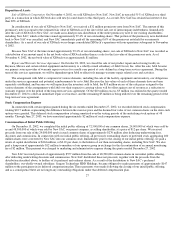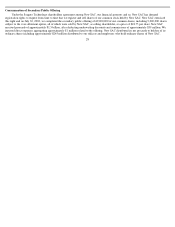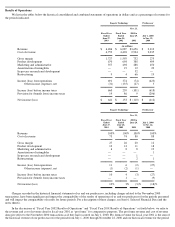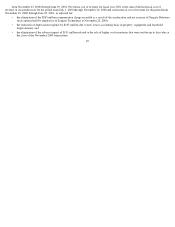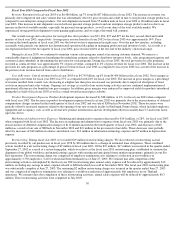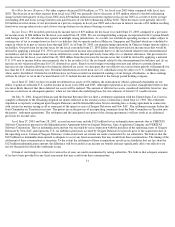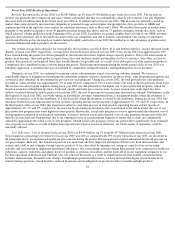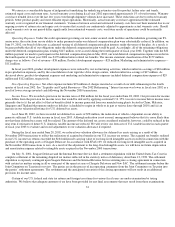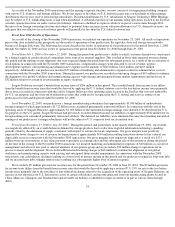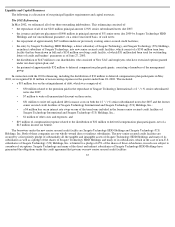Seagate 2002 Annual Report Download - page 30
Download and view the complete annual report
Please find page 30 of the 2002 Seagate annual report below. You can navigate through the pages in the report by either clicking on the pages listed below, or by using the keyword search tool below to find specific information within the annual report.
Consolidation is also occurring among our customers. For example, Compaq, our largest customer in fiscal 2001, merged with Hewlett-
Packard in our fiscal year 2002. As a result of this trend, our customer base is increasingly concentrated among fewer OEMs, potentially
providing them with increased pricing leverage. In the event that our sales to a combined entity are less than, or are on terms that are less
favorable than, our sales to these customers when they were separate entities, our results of operations would suffer.
Historically, our industry has been characterized by continuous and significant advances in technology, which contributed to rapid
product life cycles, the importance of being first to market with new products and the difficulty in recovering research and development
expenses. However, based upon the recent pace of new product introductions, we believe that our industry is entering a period in which the rate
of increases in areal density will be lower than the rate of the last several years. The slowing change in areal density contributes to:
•
the increased importance of successfully executing product transitions, as factors such as quality, reliability and manufacturing yields
become of increasing competitive importance; and
Seagate Dynamics. During the past several years we have restructured our operations to reduce our costs and improve our manufacturing
efficiency and flexibility. Since 1998, we and our predecessor have implemented restructuring plans that have resulted in total net charges of
approximately $361 million, the closing of 14 facilities and a reduction in headcount of approximately 40,000 employees. Through our Factory
of the Future initiative, we have increased the use of automation in our manufacturing operations. We believe that these changes in our
operations have added to our manufacturing flexibility allowing us to improve our responsiveness to customers and take advantage of
unforecasted sales opportunities to deliver products on short notice. Additionally, we have substantially improved our gross margin due to these
ongoing cost savings from our restructuring activities and our programs to implement operating efficiencies. We have further benefited from
reductions in depreciation expense resulting from write-downs to the fair market value of our depreciable assets in connection with the
November 2000 transactions. The favorable effects on results of operations from these lower depreciation charges in connection with the write
-
down will gradually decrease in future periods as our older assets become fully depreciated and new, higher-priced assets are acquired and
recorded at cost. We believe our reduced cost structure and improved manufacturing efficiency provides us with greater flexibility to address
changing market conditions.
We maintain a highly integrated approach to our business by designing and manufacturing components we view as critical to our
products, such as read/write heads and recording media. We believe that our control of these key technologies, combined with our innovations
in manufacturing, enable us to achieve product performance and time-to-market leadership. This leadership position has enabled us to leverage
our investments in research and development. Although we believe that we derive an important competitive advantage as a result of this
strategy, it results in higher fixed costs, which may adversely affect our financial performance in periods of declining demand. This approach
also increases the importance of realizing and maintaining substantial market share in the markets in which we compete, allowing us to spread
our technology investments across a high unit volume of products.
The slowing rate of increase of areal density has increased the importance of our successful execution of new product transitions and of
competitive factors such as quality, reliability and our manufacturing yield. We recently completed our transition to the 80 gigabyte per disc
platform for our desktop products and our improved manufacturing yields from these products have contributed to our recent financial
performance. We also have begun limited revenue shipments of our first notebook products, the Momentus disc drives, which address a
segment of the notebook computer market. Although we are shipping notebook drives to OEMs, we currently have not completed qualification
programs with a number of OEMs, which are material to the success of these products.
Because we use a fiscal year instead of a calendar year, it is necessary every four to five years to realign our fiscal quarter-ends with
calendar quarter-
ends. As a result, fiscal year 2004 will have 53 weeks and our first quarter of the year will have 14 weeks, ended on October 3,
2003. We do not expect the additional week in the first quarter to have a material impact on our operating results, as compared to what we
would have expected during a 13-week quarter.
26
•
increasing average price erosion, as product life cycles are lengthened and the ability of rigid disc drive producers to introduce new
products at higher prices is limited.


